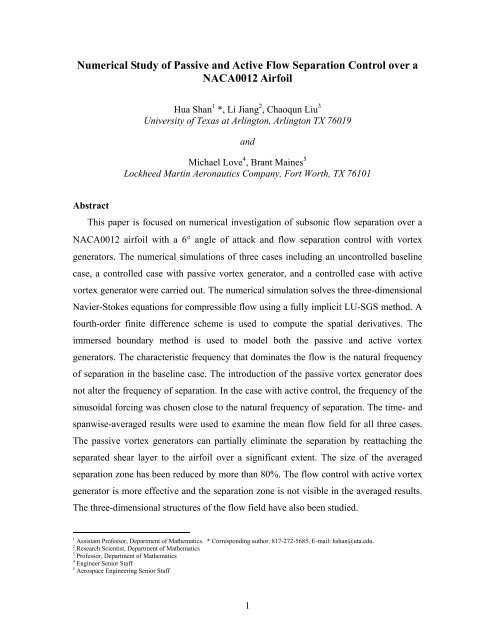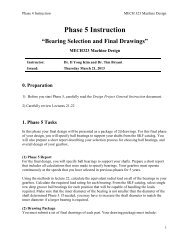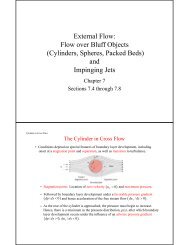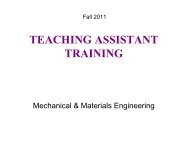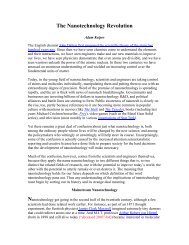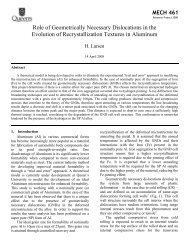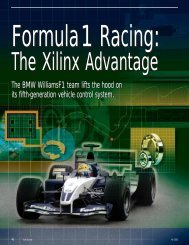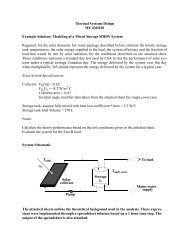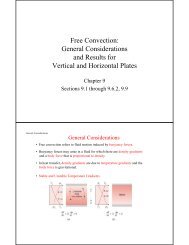Numerical Study of Passive and Active Flow Separation Control ...
Numerical Study of Passive and Active Flow Separation Control ...
Numerical Study of Passive and Active Flow Separation Control ...
Create successful ePaper yourself
Turn your PDF publications into a flip-book with our unique Google optimized e-Paper software.
<strong>Numerical</strong> <strong>Study</strong> <strong>of</strong> <strong>Passive</strong> <strong>and</strong> <strong>Active</strong> <strong>Flow</strong> <strong>Separation</strong> <strong>Control</strong> over a<br />
NACA0012 Airfoil<br />
Hua Shan 1 *, Li Jiang 2 , Chaoqun Liu 3<br />
University <strong>of</strong> Texas at Arlington, Arlington TX 76019<br />
<strong>and</strong><br />
Michael Love 4 , Brant Maines 5<br />
Lockheed Martin Aeronautics Company, Fort Worth, TX 76101<br />
Abstract<br />
This paper is focused on numerical investigation <strong>of</strong> subsonic flow separation over a<br />
NACA0012 airfoil with a 6° angle <strong>of</strong> attack <strong>and</strong> flow separation control with vortex<br />
generators. The numerical simulations <strong>of</strong> three cases including an uncontrolled baseline<br />
case, a controlled case with passive vortex generator, <strong>and</strong> a controlled case with active<br />
vortex generator were carried out. The numerical simulation solves the three-dimensional<br />
Navier-Stokes equations for compressible flow using a fully implicit LU-SGS method. A<br />
fourth-order finite difference scheme is used to compute the spatial derivatives. The<br />
immersed boundary method is used to model both the passive <strong>and</strong> active vortex<br />
generators. The characteristic frequency that dominates the flow is the natural frequency<br />
<strong>of</strong> separation in the baseline case. The introduction <strong>of</strong> the passive vortex generator does<br />
not alter the frequency <strong>of</strong> separation. In the case with active control, the frequency <strong>of</strong> the<br />
sinusoidal forcing was chosen close to the natural frequency <strong>of</strong> separation. The time- <strong>and</strong><br />
spanwise-averaged results were used to examine the mean flow field for all three cases.<br />
The passive vortex generators can partially eliminate the separation by reattaching the<br />
separated shear layer to the airfoil over a significant extent. The size <strong>of</strong> the averaged<br />
separation zone has been reduced by more than 80%. The flow control with active vortex<br />
generator is more effective <strong>and</strong> the separation zone is not visible in the averaged results.<br />
The three-dimensional structures <strong>of</strong> the flow field have also been studied.<br />
1 Assistant Pr<strong>of</strong>essor, Department <strong>of</strong> Mathematics. * Corresponding author. 817-272-5685, E-mail: hshan@uta.edu.<br />
2 Research Scientist, Department <strong>of</strong> Mathematics<br />
3 Pr<strong>of</strong>essor, Department <strong>of</strong> Mathematics<br />
4 Engineer Senior Staff<br />
5 Aerospace Engineering Senior Staff<br />
1


